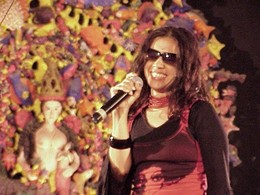13.29.2 Telmary Díaz

Telmary Díaz, a prominent Cuban singer, was born on March 10, 1977. From a very early age, she considered choosing the same career as her mother, so she studied journalism. She also had a knack for science, even winning a national physics competition, but her musical interests led her to accept an invitation from a friend to attend a musical event up close, which definitively influenced her decision to pursue singing and poetry. Her first time on stage made her immediately realize that the form of communication she most loved was music.
She studied screenwriting, theater, literature, and English. Although she didn’t study music, she is considered by many to be a “street poet,” and by others a “jazz poet,” because her high levels of improvisation have allowed her to freely position her voice. She prefers to achieve greater communication with her audience this way, without being pigeonholed into any one technique or tone. The charismatic artist formed her first band, “Free Hole Negro,” in 1999, with which she began performing live on various stages across the country and quickly became familiar with audiovisual media.
In 2002, Telmary Díaz joined the “Interactivo” project created by Roberto Carcassés. This band eventually featured up to fourteen artists at the same time, with each member pursuing an individual career. The band’s main objective was collaboration and the fusion of jazz, rock, and Cuban popular music. “Interactivo” won the 2005 Cubadisco Awards for Best Album and Best Fusion Debut.
He has also collaborated with other local artists, including Kelvis Ochoa and Kumar. He has also collaborated with international artists such as Quadrasonic (Canada), Afrika Bambaataa (United States), and DJ Kassim (Brazil).
Throughout her young career in the music world, she has developed and perfected her unique and personal style. Her work is recognized for the fire she imbues with her verses and the social message she conveys; this has earned her success in the traditionally masculine genre of hip-hop, which she infuses with urban slam poetry and touches of funk and jazz. Her work also ingeniously highlights the fusion of Afro-Cuban and Latin American rhythms.
Telmary has also ventured into film-related projects. In 2001, she made her film debut in Cecilia Araujo’s Brazilian film “Todas las noches terminan en el Malecón.” In 2002, she contributed the soundtrack to Guido Giansoldatti’s Italian film,
“MalaHabana.” In 2004, she starred in “Música Cubana” by German director Krall, and in 2005, she worked for Spanish cinema in Benito Zambrano’s film, “Habana Blues.”
In 2007, he released his first solo album, the CD “El Diario,” produced by Roberto Carcassés and Yusa. The album featured collaborations with talented artists such as Juan Formell, William Vivanco, Mayito Rivera, Athanai (Spain), among others. The work received very positive reviews. He won an award for Best Hip Hop Album at that year’s Cubadisco edition, and the magazine “Lo mejor de Toronto” (Canada) awarded him Best Latin Artist.
Telmary Díaz is always working, whether writing or acting. Based in Canada, she recently completed her second annual “Havana Cultura” tour in Toronto. Her handcrafted garments—scarves, turbans, and hats—along with her sensual voice and outstanding professionalism make this young woman one of the most authentic representations of Cuban culture.








